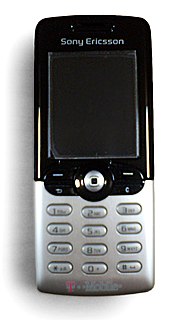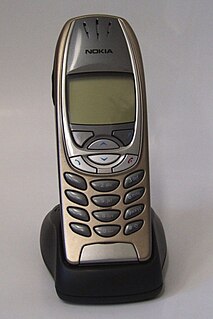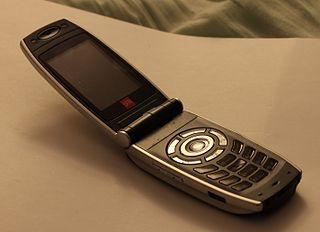The Sharp GX15 is a tri-band GSM mobile phone designed by Sharp Corp (Japan).
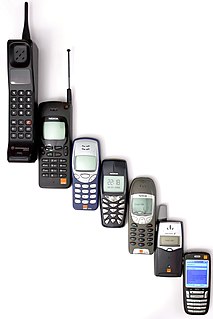
A mobile phone, cell phone, cellphone, or hand phone, sometimes shortened to simply mobile, cell or just phone, is a portable telephone that can make and receive calls over a radio frequency link while the user is moving within a telephone service area. The radio frequency link establishes a connection to the switching systems of a mobile phone operator, which provides access to the public switched telephone network (PSTN). Modern mobile telephone services use a cellular network architecture, and, therefore, mobile telephones are called cellular telephones or cell phones, in North America. In addition to telephony, 2000s-era mobile phones support a variety of other services, such as text messaging, MMS, email, Internet access, short-range wireless communications, business applications, video games, and digital photography. Mobile phones offering only those capabilities are known as feature phones; mobile phones which offer greatly advanced computing capabilities are referred to as smartphones.
This model was almost exclusively sold by Vodafone in both Europe and Australasia. Sister model GZ100 was sold by Hong Kong's SmarTone.
Vodafone Group plc is a British multinational telecommunications conglomerate, with headquarters in London and Newbury, Berkshire. It predominantly operates services in the regions of Asia, Africa, Europe, and Oceania. Among mobile operator groups globally, Vodafone ranked 4th in the number of mobile customers as of 2018.

Europe is a continent located entirely in the Northern Hemisphere and mostly in the Eastern Hemisphere. It is bordered by the Arctic Ocean to the north, the Atlantic Ocean to the west and the Mediterranean Sea to the south. It comprises the westernmost part of Eurasia.

Australasia, a region of Oceania, comprises Australia, New Zealand, neighbouring islands in the Pacific Ocean and, sometimes, the island of New Guinea. Charles de Brosses coined the term in Histoire des navigations aux terres australes (1756). He derived it from the Latin for "south of Asia" and differentiated the area from Polynesia and the southeast Pacific (Magellanica). The bulk of Australasia sits on the Indo-Australian Plate, together with India.
Has the following features:
- 640x480 CMOS Digital Camera
- 65K-color (120x160 dot total) (120x147 dot useful) QQVGA TFT LCD
- Tri-band (GSM 900, 1800, 1900)
- 1.8MiB Flash memory
- Java virtual machine MIDP2.0+VSCL1.1
- Bluetooth V1.1
- IrDA
- USB Interface (uses proprietary data cable)
- WAP Openwave v6.2.3
- MMS
- GPRS class-10
- Clock
- 6 Alarm clocks
- Calendar
- Calculator
- Currency converter
- Enhanced Phonebook
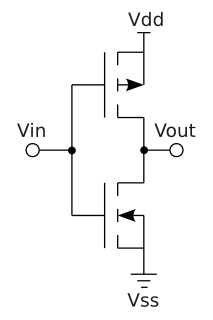
Complementary metal–oxide–semiconductor (CMOS) is a technology for constructing integrated circuits. CMOS technology is used in microprocessors, microcontrollers, static RAM, and other digital logic circuits. CMOS technology is also used for several analog circuits such as image sensors, data converters, and highly integrated transceivers for many types of communication. Frank Wanlass patented CMOS in 1963 while working for Fairchild Semiconductor.

GSM is a standard developed by the European Telecommunications Standards Institute (ETSI) to describe the protocols for second-generation (2G) digital cellular networks used by mobile devices such as mobile phones and tablets. It was first deployed in Finland in December 1991. As of 2014, it has become the global standard for mobile communications – with over 90% market share, operating in over 193 countries and territories.

Flash memory is an electronic (solid-state) non-volatile computer storage medium that can be electrically erased and reprogrammed.
Being targeted at the lower-specification end of the product spectrum, it does not have the following features:

A stopwatch is a handheld timepiece designed to measure the amount of time that elapses between its activation and deactivation. A large digital version of a stopwatch designed for viewing at a distance, as in a sports stadium, is called a stopclock. In manual timing, the clock is started and stopped by a person pressing a button. In fully automatic time, both starting and stopping are triggered automatically, by sensors.
MP3 is a coding format for digital audio. Originally defined as the third audio format of the MPEG-1 standard, it was retained and further extended—defining additional bit-rates and support for more audio channels—as the third audio format of the subsequent MPEG-2 standard. A third version, known as MPEG 2.5—extended to better support lower bit rates—is commonly implemented, but is not a recognized standard.
SyncML is the former name for a platform-independent information synchronization standard. The project is currently referred to as Open Mobile Alliance Data Synchronization and Device Management. The purpose of SyncML is to offer an open standard as a replacement for existing data synchronization solutions, which have mostly been somewhat vendor-, application- or operating system specific.
It weighs 84g and its size is 17.8 x 105 x 45 mm.
A custom-designed connector is used to both charge the phone battery and connect to the computer via USB. This same connector style is used for many of Sharp's mobile phone models.
The Sharp GX15 is designed to work with its own Handset Manager software. So, it may not work correctly with some standard PC synchronization applications: for example, remote reading of the battery level is not supported.
